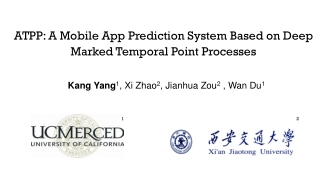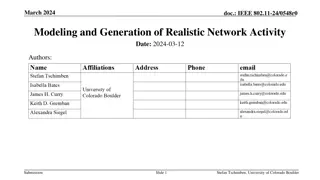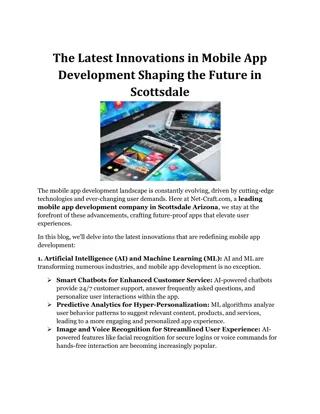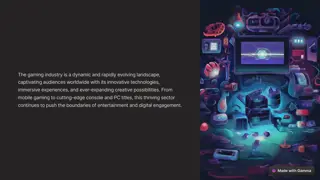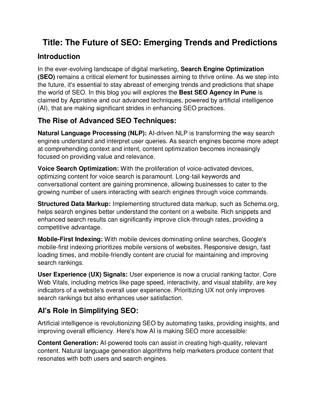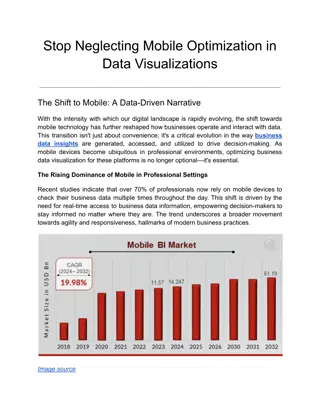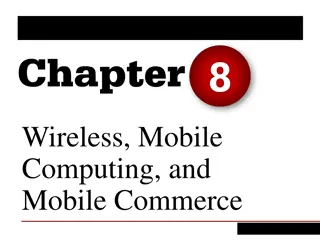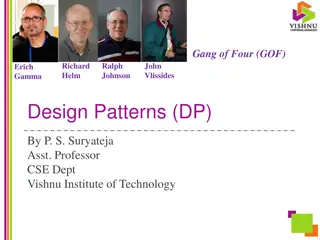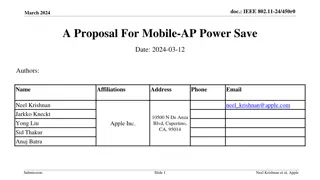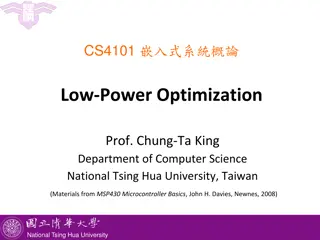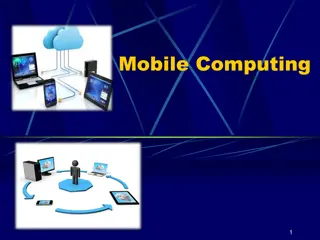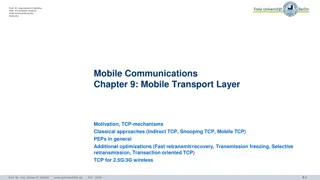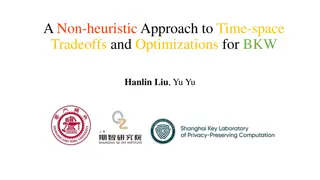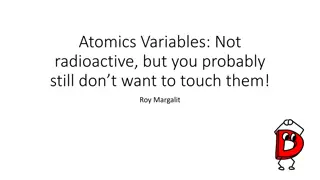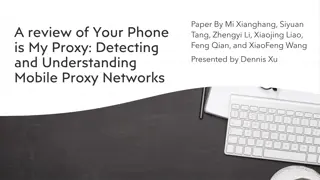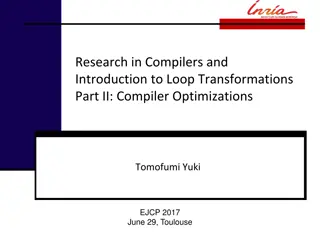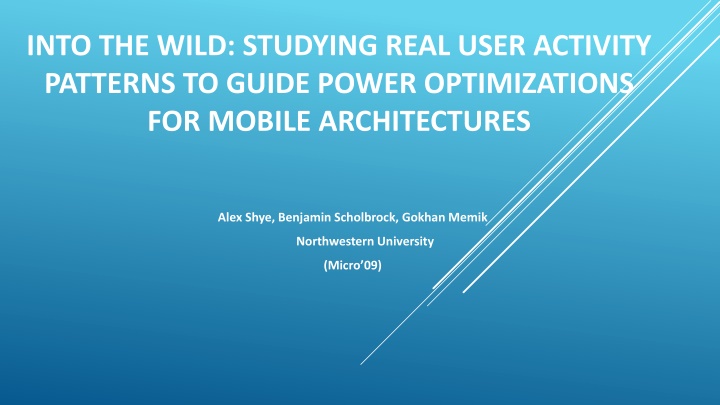
Real User Activity Patterns for Mobile Power Optimizations
Studying real user activity patterns to optimize power consumption in mobile architectures is crucial due to limited battery life. This research delves into user behaviors, system performance metrics, and power states to guide efficient power management strategies. By analyzing user activities on a rooted HTC Dream ADP1 phone running Android, the study sheds light on parameters such as CPU usage, screen brightness, network consumption, and multimedia processing. The aim is to build a robust power estimation model for enhancing mobile architecture efficiency.
Download Presentation

Please find below an Image/Link to download the presentation.
The content on the website is provided AS IS for your information and personal use only. It may not be sold, licensed, or shared on other websites without obtaining consent from the author. If you encounter any issues during the download, it is possible that the publisher has removed the file from their server.
You are allowed to download the files provided on this website for personal or commercial use, subject to the condition that they are used lawfully. All files are the property of their respective owners.
The content on the website is provided AS IS for your information and personal use only. It may not be sold, licensed, or shared on other websites without obtaining consent from the author.
E N D
Presentation Transcript
INTO THE WILD: STUDYING REAL USER ACTIVITY PATTERNS TO GUIDE POWER OPTIMIZATIONS FOR MOBILE ARCHITECTURES Alex Shye, Benjamin Scholbrock, Gokhan Memik Northwestern University (Micro 09)
Motivation Need for Optimization of Power Consumption in a Mobile Architecture. Limited Battery Life. Very limited study on patterns, properties and study of user activity The ultimate Workload
EXPERIMENTAL SETUP Mobile Architecture : HTC Dream ADP1 Phone (Android) i. ii. iii. Rooted & Sim-unlocked Version iv. Dalvik Virtual Machine supported Framework v. Qualcomm MSM7201A chipset vi. Uses 528 MHz ARM 11 apps processor vii. Supports Dynamic Frequency Scaling (124 MHz, 246 MHz, and 384 MHz) Android OS 1.0 system image Android Platform based on Linux 2.6.25 Kernel
Collection of User Activity : i. Use of a Logger application : Stores System performance Metrics + User Activity ii. No Special Hardware of Software needed. iii. Checks Network Connection, Collects User activity Information and Sends back to Server for analysis iv. Unintrusive app v. Consumes minimal Battery/System Resources. vi. Anonymity Secured vii. Analysis used data from 20 biggest loggers ~ 250 days of real user activity viii. Only certain time intervals are significant ~ 145 days of real user activity
POWER MODEL Two power states : 1. Active State : Application processor in Operation . All the time when Screen On System Wake Lock + Screen Off Typical Power Consumption ~ 300 2000 mW 2. Idle State : Low Power Sleep Mode Application Proceesor not operational Modem Processor still operational Also called standby Mode Typical Power Consumption ~ 70mW
PARAMETERS CHOSEN : 1. CPU : Application Processor , Responsible for DFS. 2. Screen : A. Offset Whether the screen is On B. Screen Brightness 3. Call : Measures time spent on ringing and actual phone call 4. EDGE : EDGE Network Power Consumption (When EDGE has Traffic + Traffic Measurement) 5. Wifi : Wifi Network Power Consumption (When Wifi is enabled + Wifi Traffic) 6. SD Card : Number of sectors transferred to/fro Micro SD card. 7. DSP : To handle multimedia file execution 8. System : Miscellaneous Power consuming factor
Parameters used for linear regression in our power estimation model
BUILDING ESTIMATION MODEL Step 1 : Collect statistics and Power Consumption about the parameters described before. Step 2 : Training : Use Input from Step 1 to feed to R-tool to build linear regression Model (cj for each parameter) Step 3 : Can Predict Power now! Total Power : For m samples :
BUILDING ESTIMATION MODEL Total Energy with Sampling period ts: Overall Power Consumption (inclusive of Idle state : )
POWER MODEL VALIDATION Collect additional logs (System measurement and Power)on separate device as well Log notation : 1. Runi_Unit - Specific Hardware 2. Scenarioi Mix of hardware components involved Absolute relative Error for sample i : Relative Error : Even though two devices are used : Median relative Error is observed : <0.1%
STUDYING THE USER ACTIVITY Power breakdown excluding idle time Power breakdown including idle time
SOME USEFUL DATA : 1. Idle state averages to 49.3%, Active State to 50.3% 2. Biggest three consumers in Active Stage : a. Screen Brightness : 19.2% b. Screen On : 16.3% c. CPU : 12.7%
SCREEN USAGE DATA : Screen Interval : Continuous interval of time when screen is on. Screen Duration : Screen Intervals Inference : Most useful to optimize for Power during long screen Intervals
OPTIMIZATIONS Change Blindness : o Humans not capable of detecting dynamic changes in surroundings if, o Their attention is elswhere and o The changes are gradual o An interesting video : https://www.youtube.com/watch?v=0grANlx7y2E How to use Change Blindness : o Reduce Screen Brightness o Reduce CPU frequency o Do it Slowly!
CPU OPTIMIZATION SCHEME Existing Dynamic Frequency Scaling : A. If Apps processor Active + Screen On : Use 384MHz B. If Apps processor Active + Screen Off : Use 246MHz OnDemand DFS : A. Powersave_bias : Range 0 to 1000 B. Frequency change interval : 0.1% C. Increase Powersave_bias by 30 per 4 secs Till 300 is reached D. If Screen is turned off : Reset to Zero E. So reaches 70% of frequency requested in 40 seconds
SCREEN OPTIMIZATION SCHEME When Screen On, start the timer After every 3 seconds reduce brightness by 7 units Range of Brightness : 0 255 Continue till brightness reaches 60% of user-set When Screen turned off : Set brightness back to user-set No reduction of power in small intervals since the brightness decrease is slow. User will not notice the decrease in brightness.
RESULTS Screen and CPU Ramp : Reducing Brightness and frequency based on Optimizations Screen and CPU Drop : Wait 30 seconds, then move to the value eventually Ramp scheme reaches abruptly Power savings of 10.6% overall Total system power savings for each of the optimizations as estimated by our power model
USER FEEDBACK Average user satisfaction of 4 on 5 (scale of 1-5), also depends on the application Once application becomes jittery, doesn t matter if freq decrease is via CPU Drop or CPU romp. If 8 out of 20 could detect brightness drop in Screen Drop, Only 1 in 20 could do for Screen Romp 15 of 20 willing to use architecture with these optimizations 5 of 20 prefer application dependent optimization.
RELATED/FUTURE WORKS Use performance counter and (or) Communication measurements to estimate power consumption Power consumption of OS Software implemented power estimation without any specialized hardware performance counter or Software hooks into OS Screen optimization with OLED technology, to dim certain parts of screen. Scale to huge number of users now With more complex apps in 2015, study could give more deeper insights into user activity


